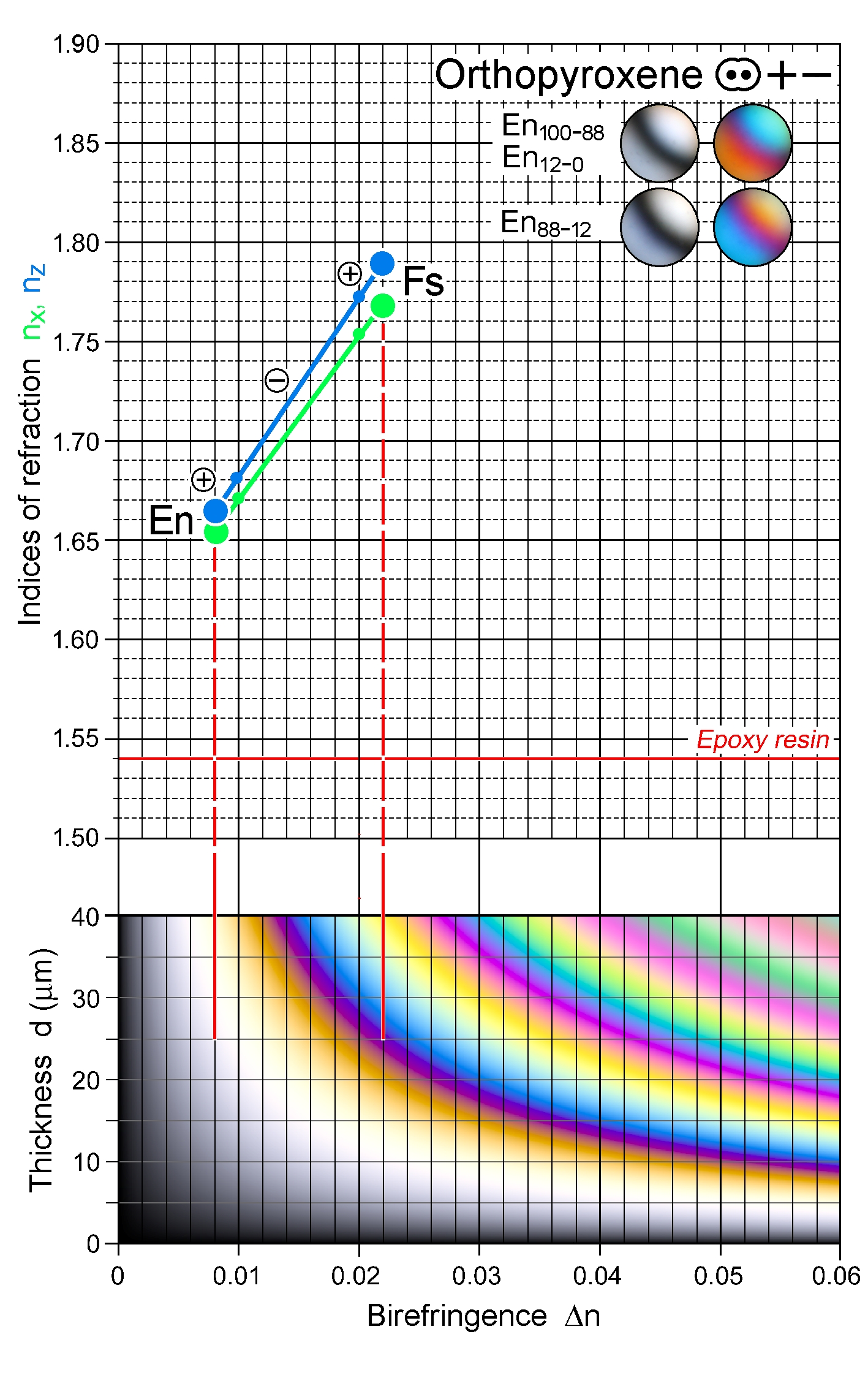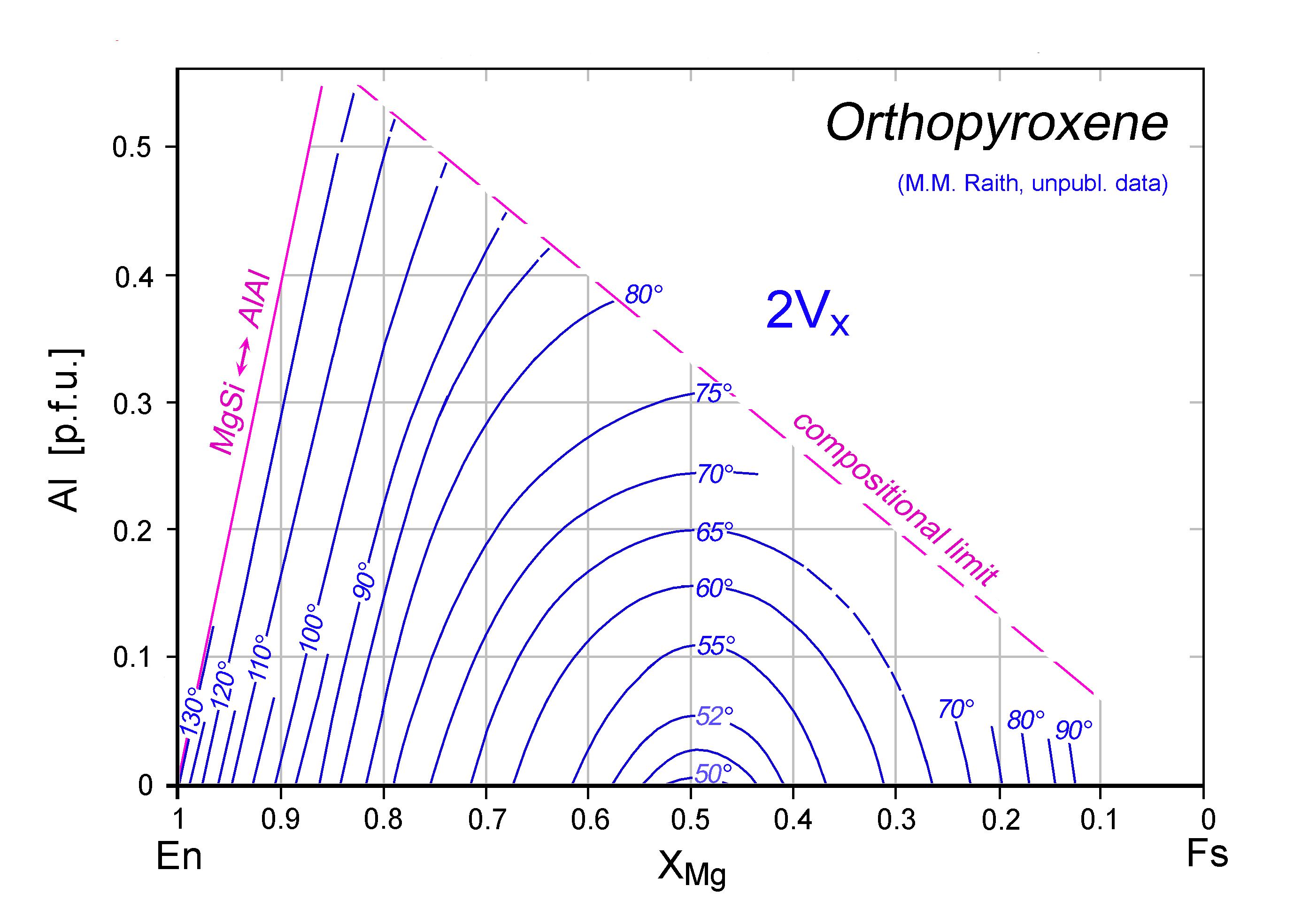|
| Formula | (Mg,Fe)2SiO6 |
| | Optic class & sign | Biaxial positive or negative |
| | Optical orientation | a = X, b = Y, c = Z |
| | Optical plane | (010) |
| | Relief | High |
| | Refractive indices | nx = 1.649 -1.768
|
|
ny = 1.653 -1.770
|
|
nz = 1.657 -1.788
|
|
| n increases with increasing Fe and Mn, also with increasing Al (Tschermak substitution) |
| | Birefringence (max.) | 0.007 - 0.020 |
| | | Δn increases with increasing Fe and Mn; compositional zoning can occur, specifically in volcanics |
| | Optic Angle
| 2Vx
= 52 - 90° |
| | 2Vz
= 90 - 50° |
| | Sign of elongation | Length-slow, l (+) |
| | Interference figure | 2V changes rapidly with Opx composition. Close-to-endmember compositions are optically positive, intermediate compositions at <90 mol% En or Fs are negative. Depending on composition, sections ⊥ c or (010) sections yield acute bisectrix figures; 2V is generally above 50°. |
| | Colour / pleochroism | Colourless (if Mg-rich) to distinctly coloured, with characteristic pleochroism X = pink, Y = light brown to yellow, Z = light green |
| | Zoning | |
|
|
| Form | Habit | Granular, short-prismatic |
| | | Surface | Anhedral (in intrusives and granulites) to euhedral (phenocrysts in volcanics) |
| | Cleavage | 2 sets {110} distinct, at 93 and 87° (seen in sections ⊥ c); parting on {100} and {010}, and parting related to inherited exsolution lamellae on pigeonite {001}. In prismatic sections, the traces of the two principal cleavage sets are parallel. |
| | Twinning | |
| | Extinction | Straight with respect to cleavage and prism faces in prismatic sections. Symmetrical extinction to {110} cleavage and {110} faces in sections ⊥ c. Narrow-spaced fine-lamellar unmixing ∥ {100} may obscure extinction position. |
|
|
| Reaction textures | Late-magmatic reaction rims of Ca-pyroxene or olivine |
| | Alteration / decomposition | Serpentine (bastite: serpentine pseudomorph after Opx), low-temperature amphiboles, talc, magnesite |
|
|
| Occurence | Ign | Mafic rocks, peridotites, pyroxenites, komatiites; also in intermediate and felsic intrusives |
| | | Met | Mafic granulites, charnockites; Fe-rich Opx in meta-ironstones; cordierite-orthopyroxene granulites |
| | | Sed | |
| | | Hyd | |
| | | Other | Meteorites |
|
|
| Distinctive properties | Low to moderate Δn; straight extinction, pink to green pleochroism for intermediate members. Using 2V and Δnmax, the composition of Opx can be determined with reasonable accuracy. Commonly, Opx has a distinctly lower Δn than co-existing Ca-pyroxene, but this does not apply in general. |
| | Additional comments | Sections oblique to c will not show straight extinction. Hence, it is critical to check (010) sections that show max Δn.
The occurrence of Opx showing exsolution lamellae of Ca-pyroxene at a large angle, but not orthogonal, to c testifies for the original presence of monoclinic pigeonite, and is hence referred to as ‘inverted pigeonite’. An original simple pigeonite (100) twin will then develop two sets of exsolution lamellae inclined to each other along the original twin plane; this is called ‘herringbone’ structure. |
|
|

 Images
Images 



 Images
Images 

